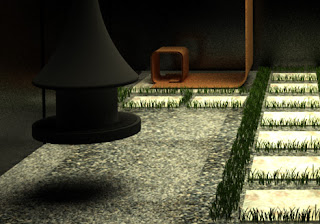The Sense of Touch
The touch sense - immediate receptors, can be found all over our human body, from the skin, membranes, and muscles. Those receptors allow us to feel the environment physically by touching, and they also offer us the sensitivity to heat gain and loss. For people who are visually impaired, this sensory is very essential to them, as they communicate with the surrounding through touching things. In many ways, Architects and Designers plan and build the built environment to connect with our sense of touch. For example, The Hardness or softness of one’s floorings, changing levels of such floor, the texture of the material used on walls and the comfort of the furniture, they are all details designed for our touch experience.
The picture above shows a bathroom design by Renato Gschwend. The concept is to provide a comfortable walking experience by using natural materials. The floor here is covered in pebbles, a material that can absorb water and the temperature varies according to the room temperature.
The level of comfort is one of the key elements to look at when designing, depending on the function or the purpose of the space. There are elements that are usually felt directly such as the furniture and the temperature of the room. The picture on the left is the Minus 5 Ice Lounge in Las Vegas. This lounge has a consistent room temperature of -5 degrees, and the entire interior space is made up from ice – from the drinks counter, walls, seating and cups. In this lounge visitors can happily experience the cold atmosphere without going to the Arctic or North Pole.
For many years, building codes and regulations have set rules and requirements for visually impaired aid designs. They are very essential for the visually handicaps to navigate through buildings or spaces. The photo on the left is a scene of a Hong Kong MTR station. We can see a path made up of a common pattern of TGP to help the visually impaired person to gain a sense of orientation within the station.
Reference –
- http://dornob.com/outside-in-bathroom-exterior-interior-design-idea/
- http://www.google.com/imgres?imgurl=http://www.tatonkaplaygrounds.com/images/rubber_tile_system_below_playground_equipment.jpg&imgrefurl=http://www.tatonkaplaygrounds.com/hosting/products.html&usg=__0PGSb8XqaCaM2cTbu8GvHYJcdpQ=&h=500&w=737&sz=117&hl=en&start=0&zoom=1&tbnid=AfXL6Ds0oahRgM:&tbnh=132&tbnw=183&ei=XT5BTcaxE4L-8AbSi9G0AQ&prev=/images%3Fq%3Drubber%2Btile%2Bsystem%2Bbelow%2Bplayground%2Bequipment%26hl%3Den%26sa%3DX%26rlz%3D1G1SNNT_ENUS397%26biw%3D953%26bih%3D850%26tbs%3Disch:1&itbs=1&iact=hc&vpx=129&vpy=241&dur=1357&hovh=185&hovw=273&tx=184&ty=114&oei=XT5BTcaxE4L-8AbSi9G0AQ&esq=1&page=1&ndsp=16&ved=1t:429,r:0,s:0
- http://www.google.com/imgres?imgurl=http://annatam.com/wp-content/uploads/2009/09/IMG_3635.JPG&imgrefurl=http://annatam.com/what-to-note-taking-hk-mtr/&usg=__6b4E0O-qPfseKxeFVnNAeQ-9IlU=&h=600&w=800&sz=175&hl=en&start=41&zoom=1&tbnid=P2BxgpcBxxwf_M:&tbnh=150&tbnw=177&ei=2DlBTYPDIIP_8Abcl7mFAg&prev=/images%3Fq%3Dhk%2Bmtr%26hl%3Den%26rlz%3D1G1SNNT_ENUS397%26biw%3D953%26bih%3D850%26tbs%3Disch:10,2500&itbs=1&iact=hc&vpx=506&vpy=359&dur=2769&hovh=194&hovw=259&tx=150&ty=125&oei=jDlBTY36OMT68Aaf04G4AQ&esq=4&page=4&ndsp=16&ved=1t:429,r:14,s:41&biw=953&bih=850
- http://www.destination360.com/north-america/us/nevada/las-vegas/minus5-ice-lounge



















